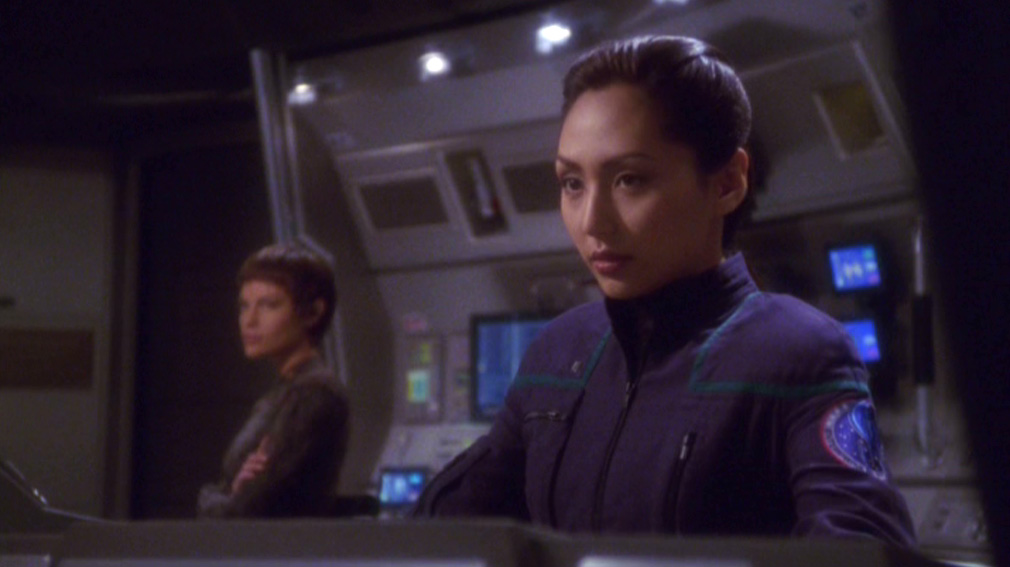 In Trek fandom, Enterprise’s Hoshi Sato (Linda Park) is often viewed as a — shall we say — less than essential crewmember. Her critics often argue that she doesn’t really contribute a lot outside of her translation and communication work. In my opinion, that’s a pretty flimsy critique, given the enormous importance of effective and accurate communication in a time when the universal translator is still a new technology with somewhat questionable reliability. But perhaps more significantly, Hoshi is an important character to those of us who have struggled with overcoming anxiety and self-doubt.
In Trek fandom, Enterprise’s Hoshi Sato (Linda Park) is often viewed as a — shall we say — less than essential crewmember. Her critics often argue that she doesn’t really contribute a lot outside of her translation and communication work. In my opinion, that’s a pretty flimsy critique, given the enormous importance of effective and accurate communication in a time when the universal translator is still a new technology with somewhat questionable reliability. But perhaps more significantly, Hoshi is an important character to those of us who have struggled with overcoming anxiety and self-doubt.
Hoshi is not your typical Starfleet officer. While she is eager to learn new alien languages, space exploration isn’t particularly appealing to her. As Phlox (John Billingsley) suggests in the season one episode “Fight or Flight,” her disposition is arguably more suited to teaching at Starfleet Academy than serving on a starship. Whereas her detractors like to suggest that this hesitancy makes her less interesting as a character, I believe it’s what makes her more compelling. As someone who is often overly deliberative and who has struggled at times with a fear of uncertainty, I find Hoshi’s outlook highly relatable. And it is deeply gratifying to see a character who has the same kind of fears and anxieties that I’ve experienced succeeding in Starfleet.
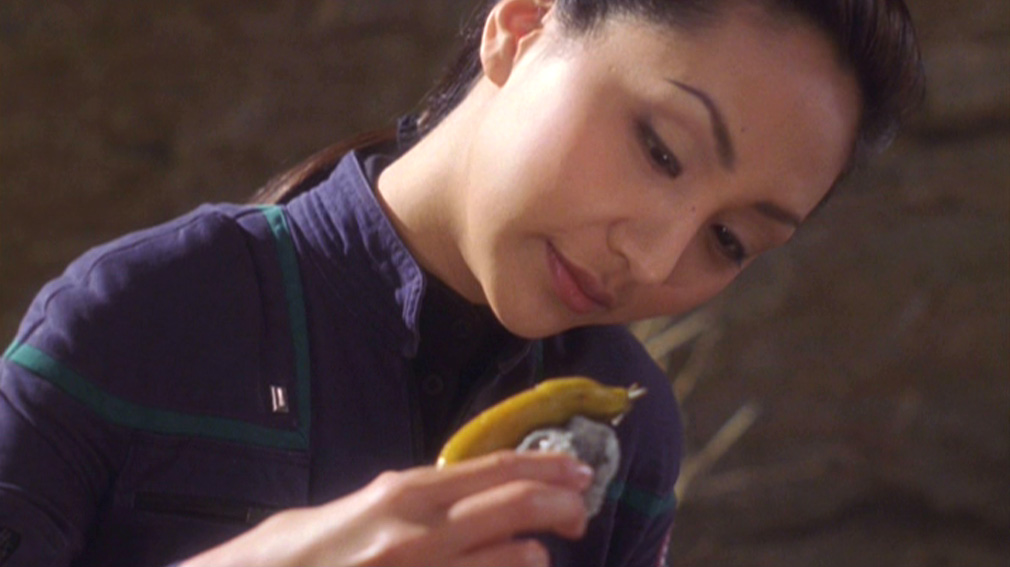
Indeed, by the end of “Fight or Flight,” Hoshi’s attitude has already begun to shift. Throughout the episode, Hoshi worries about the welfare of a slug that was acquired an alien planet. The slug isn’t responding well to its new environment on the ship, and Hoshi identifies with it to a degree that is admittedly a little heavy handed. By the conclusion, Hoshi has left the slug on a new planet and, before returning to the ship, says to the slug, “It’s not that hard to adapt.” Of course the implication here is that Hoshi is beginning to have more confidence in her own ability to adjust to her new situation and to succeed in a setting that is outside her comfort zone.
It is concerning that the only Asian woman on the show is portrayed as being somewhat timid and fearful, at least early on. This perpetuates highly problematic stereotypes that certainly should have been taken into greater account. But over the course of the series, Hoshi discovers that she has a deep well of courage to draw upon and, indeed, overcomes her fears on numerous occasions. I would argue that, at least in some ways, this makes her even more heroic than a character like Riker (Jonathan Frakes), for example, who has a naturally bold disposition and fewer internal struggles getting in the way of his ability to excel in Starfleet.
In “Fight or Flight,” for example, her self-doubt rises to the surface when she transports to an alien ship, only to encounter a number of alien corpses horrifically hanging from hooks. This is what causes her to doubt her decision to serve aboard Enterprise. But ultimately, she rallies and succeeds at completing the work at hand.
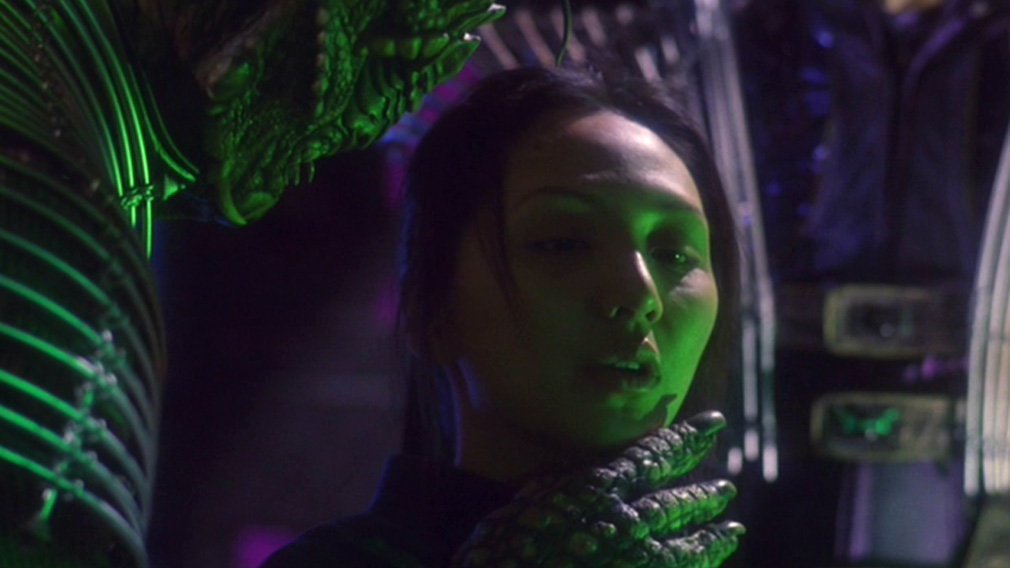
Similarly, in the season three premiere episode “Countdown,” the reptilian Xindi have Hoshi hostage, threatening her life and ordering her to decrypt the arming sequence for the weapon they intend to use to destroy Earth. Instead, Hoshi actually adds another layer of encryption, despite her life being on the line. Indeed, one of the Xindi remarks that Hoshi is “surprisingly strong-willed for a primate.” That’s not an adjective that would likely have been used to describe her in season one, and we can see how far she has come.
In season two’s “Vanishing Point” and season three’s “Exile,” we see Hoshi’s ability to believe in herself and what she feels to be true even in the face of gaslighting. In “Vanishing Point,” she uses the transporter, at this point still a new technology, for the first time. After she beams back to the ship from a planet that’s experiencing severe storms, she begins to slowly disappear as her molecules dissipate into nothingness. Ultimately, she finds herself putting her life on the line again to save the ship from aliens who are preparing to deploy a bomb. Or at least, that’s what she thinks is happening. At the end of the episode it is revealed — disappointingly in my opinion — that what she has experienced was only an illusion caused by a transporter malfunction. But ultimately, that’s not important in terms of understanding Hoshi’s character. Not only does she demonstrate once more that she is willing to risk her safety for the good of the crew, but she also sticks to her guns when Phlox and others dismiss her concerns about disappearing. In her experience of events, her molecules absolutely are dissipating, and she doesn’t allow the disbelief of others to cause her to doubt herself.
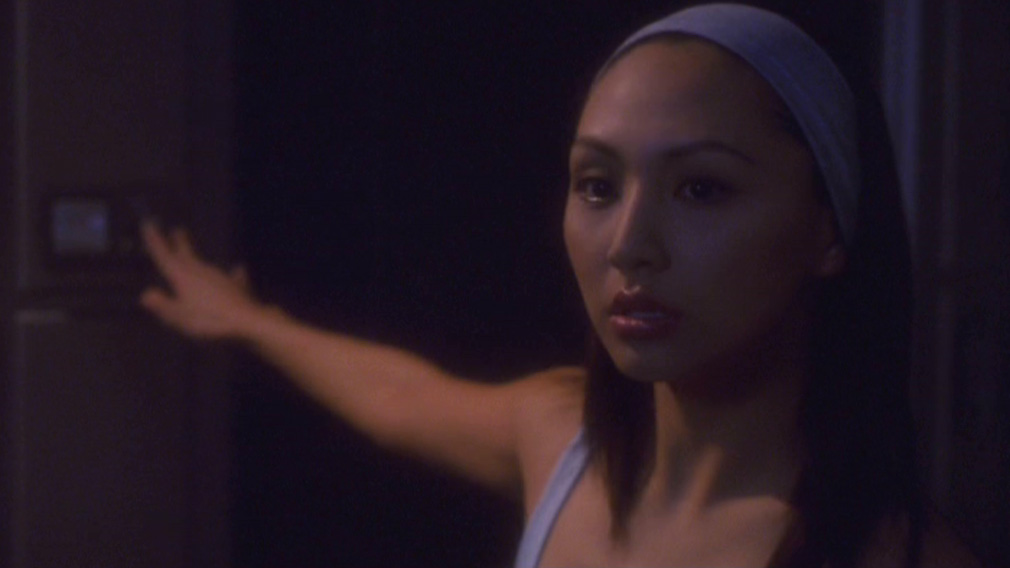
Similarly, in “Exile,” Hoshi is contacted telepathically by an alien who will go on to claim he can help the crew locate part of the Xindi weapon on the condition that Hoshi stays on his planet with him. Phlox initially doesn’t believe Hoshi when she relates her experience to him, actually telling her it appears to be in her head. While Hoshi does experience momentary self-doubt, she later emphatically says to Archer (Scott Bakula), “This is real.” And when the alien suggests he can help them, she volunteers to stay on his planet. So as in “Vanishing Point,” Hoshi demonstrates both a willingness to take risks for the greater good, and an ability to believe in the truth and validity of her own experiences despite gaslighting from others.
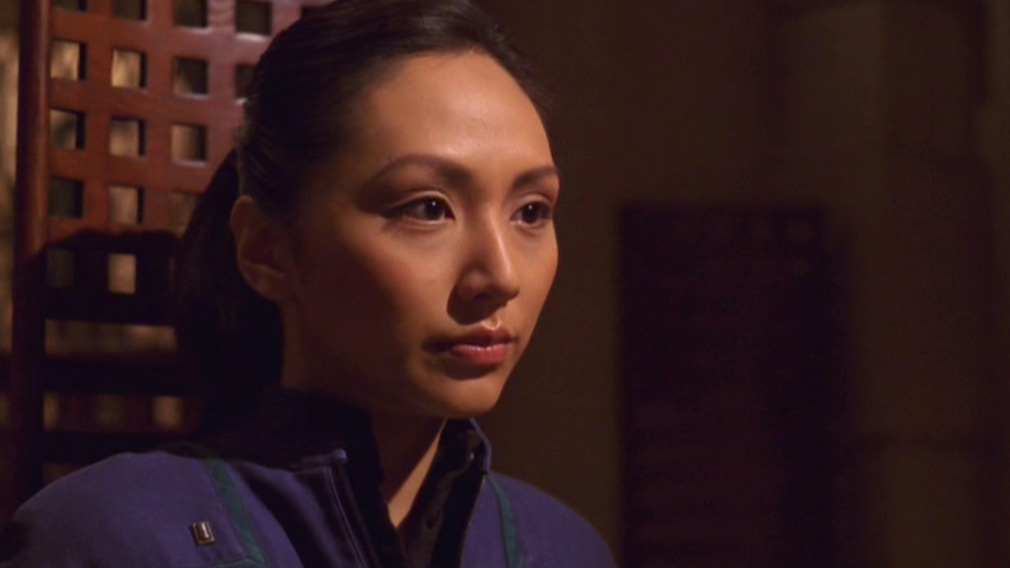
For those of us who have had challenges with self-doubt, it can be easy to allow ourselves to be held back by the fear that we’re not capable of stretching or succeeding in new environments. But Hoshi is a character who demonstrates that it is possible to grow and to build a more expansive life, even in the face of fear and anxiety. We can’t all be Kirks or Janeways. But Hoshi’s arc over the course of the series shows that even those who may not fully identify with the more gung-ho characters in Trek can still chart a path that is exciting and rewarding. And for fans like me, that makes her a very important and valuable character.
Thank you so much for sharing this wonderful piece. I have ADHD and struggle terribly with self-doubt and rejection sensitive dysphoria. Because of the RSD I have an intense fear of making mistakes. That fear can be so overwhelming that I will have panic attacks and/or completely shut down. The scene in “Fight Or Flight” when Hoshi is on the bridge and terrified that she’ll mess up is SO relatable. I can’t tell you how many times I have felt that way, even when I knew I was the most capable and qualified person for a task. I see myself in Hoshi more than any other character in Star Trek.
As we get more and more post Enterprise work what strikes me forcibly is how natural the playing looks in Enterprise by comparison. Characters post Enterprise tend to ware their issues on their sleeve which is distracting from the story telling. Linda is beautiful and offers a nice understated performance, that she is Japanese is less important than she is seen as an intellect with great problem solving skills and is crucial without being heroic which is nice touch.
In order to show equality there is a tendency with NG and Enterprise (shows I know) to flatten out cultural differences thats a shame and in Hoshi’s case her traditions could have given colour to stories. Trip is from the Southern United States and you know it. I would like to have seen Hoshi’s cultural background in the story in the same way.
I also think that T’Pol and her should have gone up against each other. Hoshi’s clear sightedness against T’Pols issues.